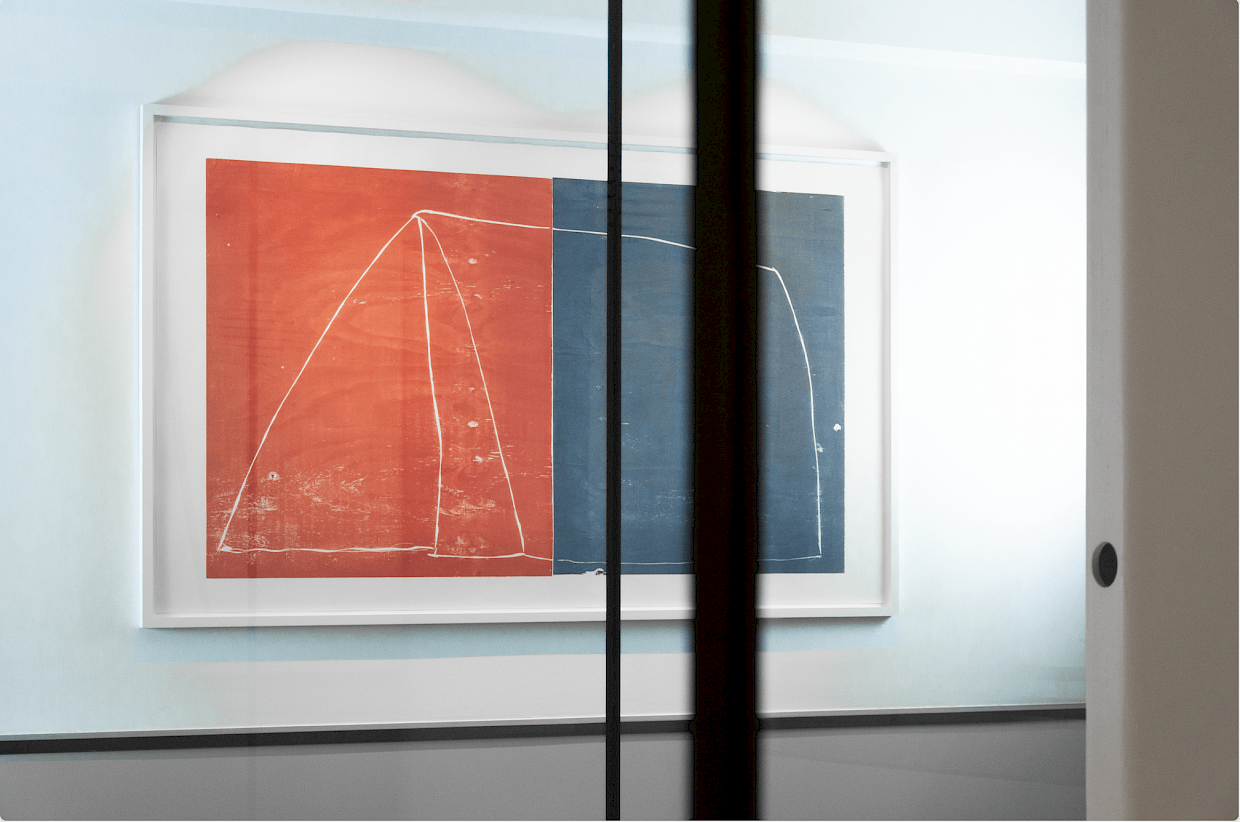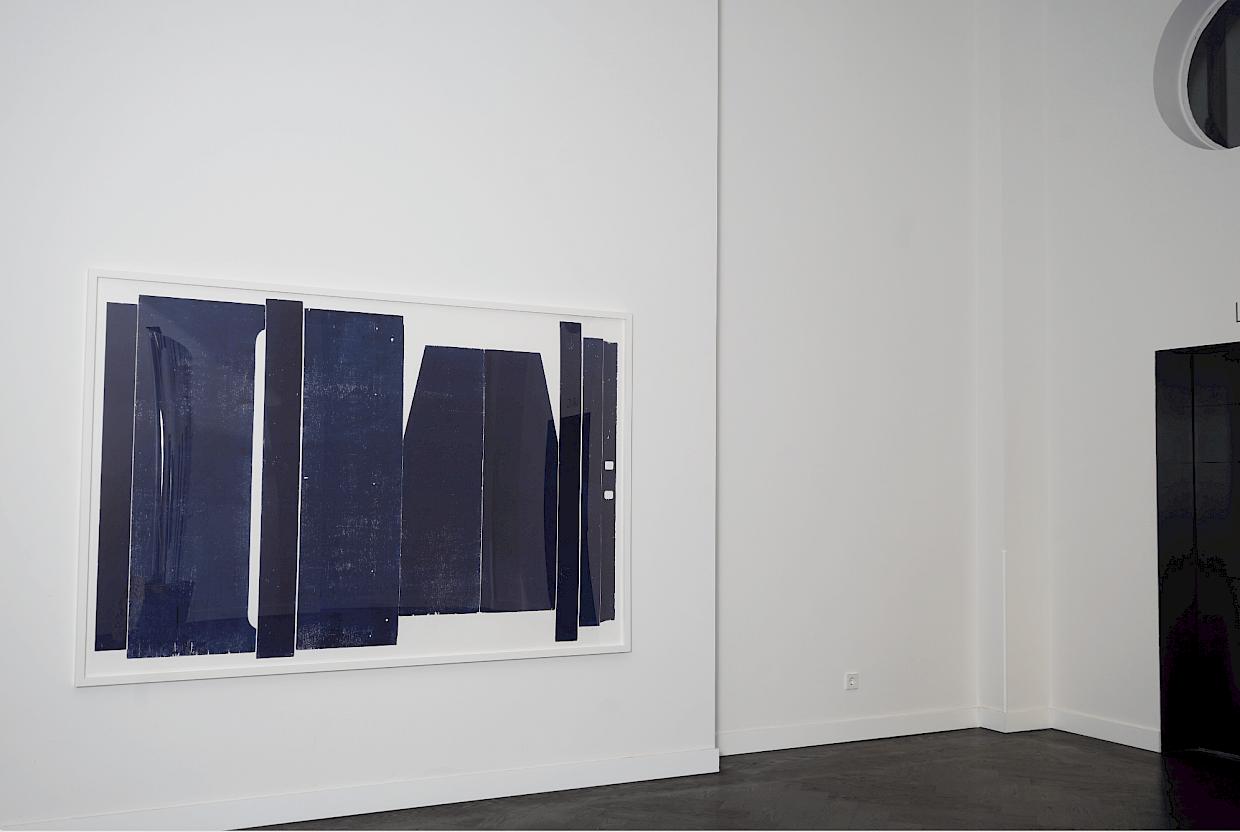

Andrea Büttner (b. 1972)
Tent (Red/Blue)

There’s a prehistoric cave in the French region of Périgord Noir where a 500-metre long corridor into the earth leads to a small space with just one mural. The mural shows a painted and carved image of a three-dimensional tent with a stark similarity to Andrea Büttner’s Tent. It’s likely to be one of the earliest European artistic representations of a single, basic dwelling.
Simplicity is central to Büttner’s series of woodcarvings depicting tents. In 2012, a similar series of carvings entitled The Poverty of The Riches was shown at the 13th Documenta in Kassel and at the Whitechapel Gallery in London.
One of the starting points for the series was Francis of Assisi, a saint who lived in the 12th century. After living a life of wealth and abundance, Francis became a symbol of simplicity and charity. Francis came to his senses when he met a leper, overcame his disgust and gave him his robe and a generous amount of alms. He then decided that no one should live in greater poverty than himself. No matter how little he had, he would share his possessions with whoever needed them more than he did. Büttner’s Tent is a wonderful metaphor for Francis’s robe, as it provides shelter to life and limb. Instrumental to humanitarian aid, the tent as an object is now more relevant than ever.
Alongside Francis’s vow of poverty, the Arte Povera art movement has been a source of inspiration for Büttner. The phrase Arte Povera was invented in 1976 by authoritative Italian art critic Germano Celant. Central to Arte Povera are simple, daily objects (sometimes even found on the streets) that are brought back to life by combining them with other artefacts. Organic materials (such as wood, feathers, leaves, stones, etc.) are often combined with technical materials, such as tarpaulins, glass objects, neon lamps and machine parts. A tent is, in reality, merely a combination of a few sticks and a tarpaulin.
With Büttner being a German artist, it doesn’t come as a surprise that woodcarving is essential to her artistry. Germany has a strong tradition of woodcarving printers dating back to the late middle ages. Take the works of Albrecht Dürer, for example, or early 20th century expressionist Ernst Ludwig Kirchner. The practice of wood carving is associated with life in monasteries, where time stands still and a rushed feeling does not exist. A few years ago, Büttner made a six-month-long trip through Italy, travelling from monastery to monastery and visiting other places that are somehow related to Francis of Assisi. In this silence and exclusion, she found the tranquillity she needed to carve wood and to print these monumental sheets.

Andrea Büttner (b. 1972)
Piano

In 2014, Andrea Büttner created her film Piano Destructions, for which she collected historical footage of performances where (male) artists destroy pianos, combined with shots of her own performance in which she plays Schumann and Chopin, along with nine female pianists. She deliberately creates a clichéd dichotomy of well-behaved young ladies who are taught how to play the piano as part of their upbringing versus hormone-driven men who abuse pianos in various ways.
The destruction of an instrument is where this woodprint comes to life. The print is created by pressing inked piano parts onto paper. This approach is different from the way Büttner created another print in the A&O Shearman collection, Tent being a classic linocut. She cuts or gouges the parts that show as empty spaces in the print. In the case of Piano, however, she presses actual parts of the piano onto the paper, lined up against each other.
Left of the centre we see the keyhole you normally find at the front end of the piano, used to lock the piano. On the right side, we see the two empty front-end spaces reserved for the pedals. For the print, Büttner has deliberately avoided displaying the actual piano keys. This way, the idea of the deconstructed piano is subtle, leaving ample room for imagination.
Ideally, this woodcut is shown in combination with the videos mentioned before, but it also possesses a great aesthetic beauty as a stand-alone piece. Having chosen this particular composition, Büttner creates three-dimensionality and depth. From chaos – a destroyed piano – comes regularity and order. The viewer sees a structure of partitions and it feels as if one can wander through it. The colours Büttner chose to work with are important; every association with piano-brown or lacquered black is avoided. Because of the entire transformation of wood – from soundboard to print surface – it is only the title of the work that still reminds the viewer of a piano.
There are several versions of this work, all of them coloured differently. Every version is unique and limited to one copy. Both Tate Modern in London and the Ludwig Museum in Cologne carry versions in their collections.
